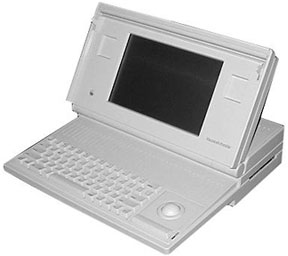Mac Musings
The Misunderstood Macintosh Portable
Daniel Knight - 2009.01.19 -
Follow Low End Mac's blogs: LEMblog and Low End Mac Services.
The Macintosh Portable may be the most misunderstood computer Apple ever built. Even here at Low End Mac we've made fun of it for it's nearly 16 lb. weight.

The nearly 16 lb. Macintosh Portable
One of the important design ideals for the original Macintosh was that it be transportable, a computer you could pack up, throw in a bag, and take with you. Much like the later iMac, the original Mac was designed so that you only had to plug in AC power, a mouse, and a keyboard to use it. The facilitate transportation, early Macs even came with a carry case.
The first Mac weighed 16.5 lb. plus mouse and keyboard, and it wasn't really a problem packing up my Mac Plus to haul it between home and work - not even with the addition of a floppy drive and, when finances allowed, a hard drive. My black Apple carry case had pouches for the mouse, all the cables, floppy disks, and manuals.
Although I can't locate a resource to confirm this at the moment, I believe one of the ideas during the original Mac design phase was including a backup battery, allowing the user to put the computer to sleep, pack it up, haul it to another location, set everything up, and resume where you had left off.
It's Not a Laptop
Anyhow, the idea behind the Macintosh Portable was never to create a laptop computer. It was to create a more portable version of the Macintosh, one that could be run without AC power.
The first portable computer was the Osborne 1, which weighed 23.5 lb., was the size of a small suitcase, and only ran off AC. The first clamshell notebook was the GRiD Compass, which weighed 10.75 lb., had an electroluminescent display, and normally ran off AC power, although there was a battery option. Early portables ran the range from briefcase-sized AC-only models to battery powered laptops.
Apple was careful in choosing the name for its first self-contained Macintosh, a name that implied that it was a full-fledged Macintosh. And it was - it had a 16 MHz 68000 CPU, a 640 x 400 active matrix LCD screen, a full-sized keyboard, a built-in trackball, room for 9 MB of RAM, and a battery that weighed over 2 lb. and could run the Portable for up to 10 hours.
To conserve battery power, the Portable used a 68000 CPU, not the more powerful 68030, and static RAM, which is fast and expensive.
The Mac Portable used a special 3.5" Conner hard drive designed for portability. Unfortunately this drive didn't use the standard SCSI interface, so it wasn't possible to simply plug in a replacement hard drive. MicroMac built an adapter kit for standard 3.5" SCSI drives; it is still available for $35.
I have two Portables in my collection, and I have to agree with others that they were very well designed. The keyboard was top notch, the trackball was the biggest Apple ever used and could be installed to the left or the right of the keyboard, and the insides were very accessible. The screen is sharp, although the lack of backlighting made it difficult or impossible to use in poor lighting.
The Portable's Legacy
Apple released a backlit Portable in early 1991, and later that year it introduced the first PowerBook models. These were designed to function as laptops, and they were much smaller and lighter than the Mac Portable.
Like the backlit portable, the new notebooks all had a trackball in front of the keyboard, supported up to 8 MB of RAM and has a 640 x 400 display. The top-end PowerBook 170 had a 25 MHz 68030 CPU and an active matrix display. The midrange PowerBook 140 used a 16 MHz 68030 and a passive matrix screen to keep costs down. Both weighed 5.8 lb. and measured 2.25" x 11.25" x 9.3".
But the PowerBook 100 was the Portable's most direct offspring. It used the same 16 MHz 68000 CPU and even used a lead-acid battery, although much smaller and lighter. Sources indicate that it used the same ROMs as the Mac Portable.
Apple had worked with Sony to miniaturize the Portable, and the PowerBook 100 was the result. It weighed less than one-third as much as the Portable at just 5.1 lb., and it had the same footprint as a sheet of typing paper, 11" by 8.5". Differences were that it used a 2.5" notebook drive and didn't have a built-in floppy drive.
I have a PB 100 in my collection, and it is eerily similar to the Macintosh Portable in use. In fact, many consider it to be Apple's first subnotebook computer.
Join us on Facebook, follow us on Twitter or Google+, or subscribe to our RSS news feed
Dan Knight has been using Macs since 1986, sold Macs for several years, supported them for many more years, and has been publishing Low End Mac since April 1997. If you find Dan's articles helpful, please consider making a donation to his tip jar.
Links for the Day
- Mac of the Day: Lisa, introduced 1983.01.19. The ancestor of the Macintosh had a mouse, a graphical interface, and a $10,000 price tag.
- Support Low End Mac